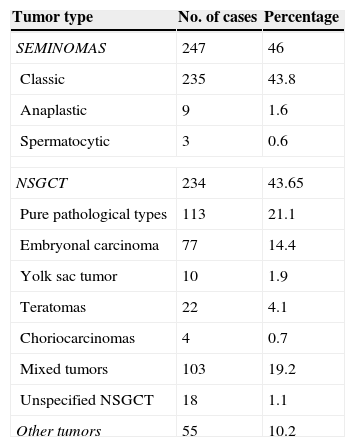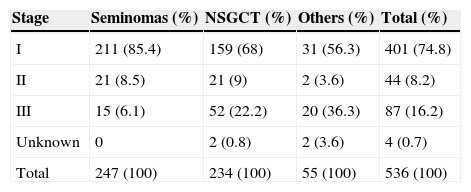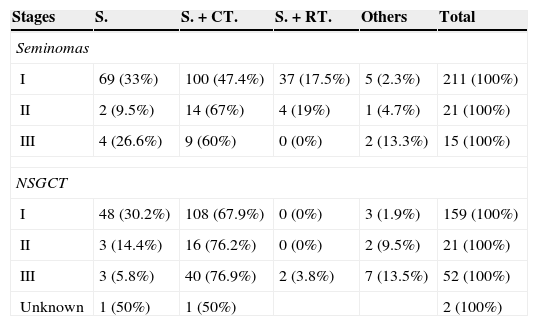To study the clinical features of the patients with germ cell tumor of testis in the Autonomous Community of Madrid, emphasizing on the different treatments used.
Material and methodRetrospective analysis of 536 patients with testicular cancer who were obtained from the Community of Madrid cancer registry, during a follow-up period of 15 years (1991–2010). Data analysis has been performed using SPSS 15.0 for Windows. Chi-square test has been used to determine possible relationships among variables. The level of significance was p≤0.05.
ResultsAn increase in the incidence rate has been detected along study period. Mean age was 33.6±13.6 years. 89.7% of cases were germ cells tumors (46% seminoma and 43.6% nonseminomatous germ cell tumor [NSGCT]) and other histologic subtypes the remaining 10.3% of cases. 74% of patients were diagnosed with stage I disease, 8.2% with stage II and 16.2% with stage III; 54.3% of patients were treated with surgery plus adjuvant chemotherapy and in 5.6% of patients the treatment was surgery plus adjuvant radiotherapy. Surgery alone was used in 27.4% of cases: in 32.7% of stage I tumors, 13.6% of stage II and 9.2% of stage III. Radiotherapy was prescribed in 10% of stage I tumors, in 9% of stage II and in 3.4% of stage III. For the seminomas: the surgery-chemotherapy association was used in 49.8 of cases, surgery alone in 30% and surgery plus radiotherapy in 16.6% of cases. For the NSGCT, surgery plus chemotherapy was used in 70.5% of patients, surgery alone in 23.5% and surgery-radiotherapy association in 0.8% of cases.
ConclusionTesticular cancer incidence is increasing. Adjuvant chemotherapy is the treatment used most frequently in the more advanced stages of both seminomas and NSGCT. The tendency to reduce the use of radiotherapy in the treatment of seminoma was confirmed.
Estudiar las características de los sujetos que padecen tumor de células germinales de testículo en la Comunidad Autónoma de Madrid, con énfasis en los distintos tratamientos empleados.
Material y métodoSe realiza un análisis retrospectivo de una serie de 536 pacientes con cáncer de testículo, procedentes del registro de tumores de la Comunidad de Madrid, durante un periodo de 15 años (1991-2010). El análisis de los datos se ha realizado con el paquete SPSS 15.0 para Windows. Se ha empleado la prueba chi-cuadrado para la búsqueda de posibles asociaciones. El nivel de significación ha sido de p≤0,05.
ResultadosSe detecta un incremento en la incidencia a lo largo del periodo de estudio. La edad media fue 33,6+13,6 años. El 89,7% fueron tumores de células germinales (46% seminoma y 43,6% tumor no seminomatoso [TCGNS]) y el 10,3% restante otras estirpes histológicas. El 74% de los pacientes fueron diagnosticados en estadio I, el 8,2% en estadio II y el 16,2% en el estadio III; 54,3% recibieron tratamiento con cirugía y quimioterapia adyuvante, y 5,6% con cirugía y radioterapia adyuvante. La cirugía sola se empleó en el 27,4% de los casos; 32,7% de los tumores en estadio I, 13,6% de los estadio II y 9,2% de los estadio III. La radioterapia se indicó en el 10% de los tumores estadio I, en el 9% de los estadio II y en el 3,4% de los estadio III. En el caso de los seminomas, la asociación cirugía y quimioterapia se empleó en un 49,8% de los casos, cirugía sola en un 30% y cirugía asociada a radioterapia en un 16,6%. En los TCGNS la asociación cirugía y quimioterapia se empleó en un 70,5%, cirugía sola en un 23,5% y la asociación cirugía y radioterapia en el 0,8% de los casos.
ConclusiónLa incidencia del cáncer de testículo está en aumento. La quimioterapia adyuvante se emplea con más frecuencia en estadios más avanzados, tanto en seminomas como TCGNS. Se confirma la tendencia a disminuir el empleo de radioterapia en el tratamiento del seminoma.









